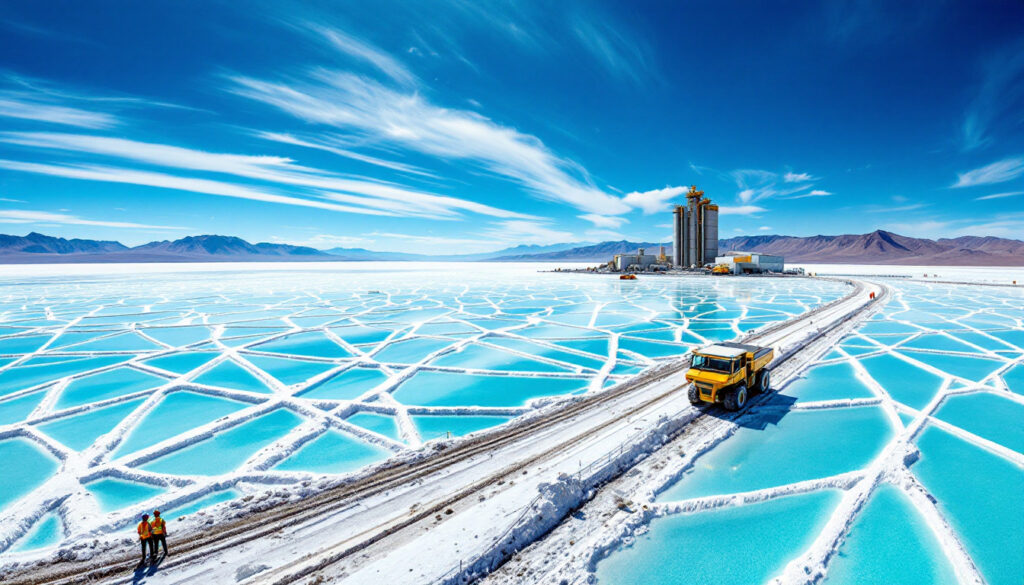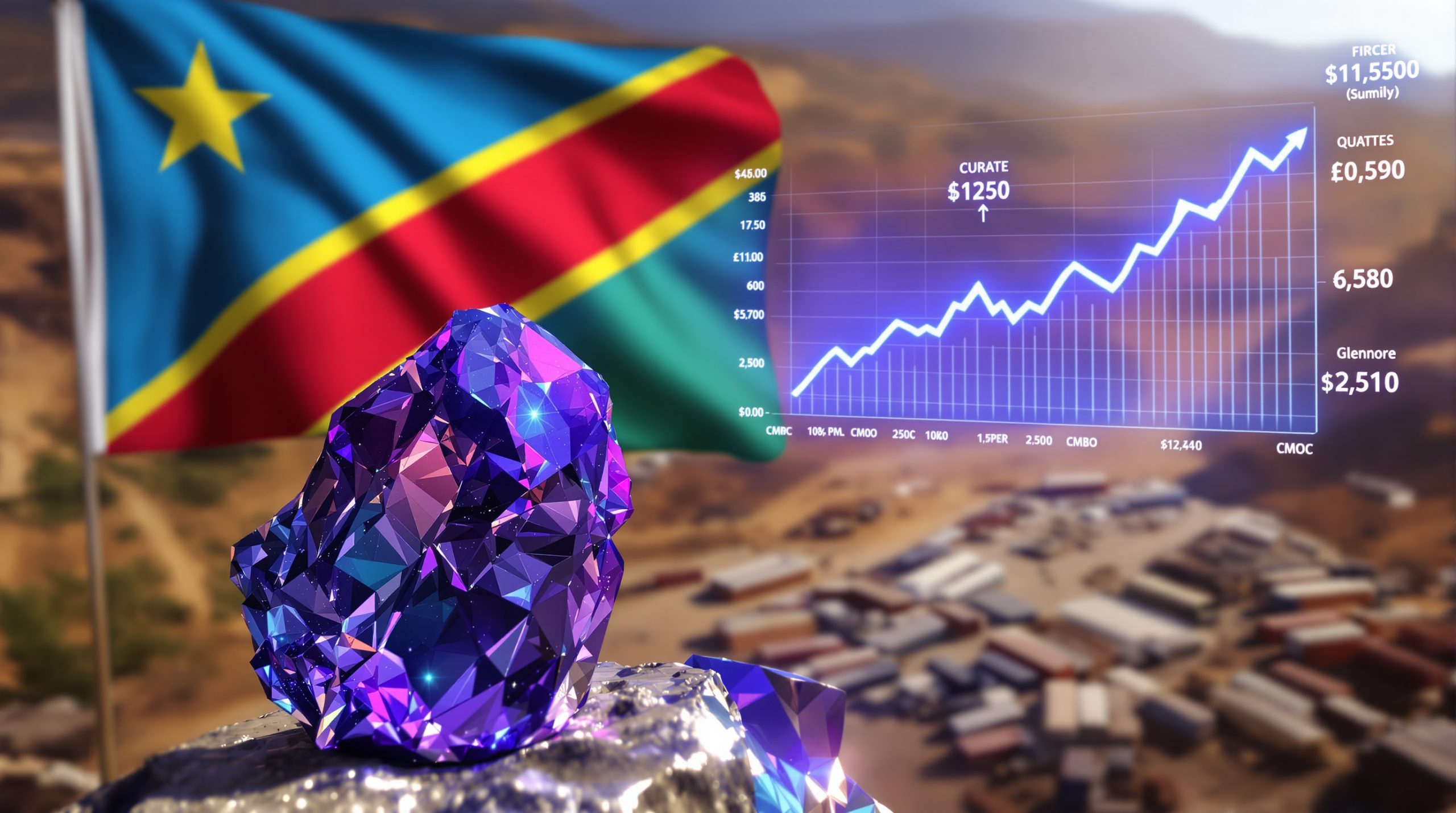Argentina's Lithium Production Boost: 75% Growth Target for 2025
Argentina's lithium industry is poised for unprecedented growth, with official targets projecting a 75% production increase to 130,800 tonnes of lithium carbonate equivalent (LCE) by 2025. This ambitious expansion, driven by new projects in Salta and scaled operations in Catamarca and Jujuy, positions Argentina to solidify its role as a critical player in the global energy transition. Industry leaders emphasize the sector's resilience to geopolitical trade tensions, citing China's dominant demand and President Javier Milei's market-friendly reforms as key stabilizers.
What Is Argentina's Current Position in Global Lithium Production?
Argentina ranks as the fifth-largest lithium producer globally, with 2024 output reaching 74,600 tonnes of LCE—a 62% year-over-year increase. This growth trajectory places the country at the forefront of South America's "Lithium Triangle," a region collectively holding 58% of the world's identified lithium resources.
Argentina aims to boost lithium production by 75% in 2025, leveraging its strategic position within this resource-rich geological formation shared with Bolivia and Chile. The country's lithium reserves are primarily concentrated in salt flats across the northern provinces, where evaporation techniques extract the valuable mineral from brine deposits.
Key Production Statistics
The Salar de Olaroz and Fenix mines contributed significantly to 2024's production surge, alongside newer operations like Sal de Oro, which commenced production in October 2024. Current capacity expansions aim to elevate Argentina's global market share from 6.2% to an estimated 10.5% by 2025.
Active lithium operations now include six facilities, with four currently producing and two in advanced development stages. This operational footprint has expanded considerably since 2020, when only two facilities were actively producing lithium carbonate.
Argentina's Position in South America's Lithium Triangle
While Chile remains the region's production leader at 230,000 tonnes LCE in 2024, Argentina's untapped brine reservoirs in the Puna Plateau offer the highest growth potential. Geological surveys indicate Argentine lithium concentrations average 690 mg/L compared to Bolivia's 540 mg/L, suggesting superior extraction efficiency potential.
This geological advantage provides Argentina with a competitive edge in production costs, with industry analysts estimating operational expenses approximately 15% lower than comparable Chilean operations. Additionally, Argentina's lithium triangle regions benefit from over 300 days of sunshine annually, optimizing the solar evaporation process critical to traditional lithium extraction.
How Will Argentina Achieve Its 75% Production Increase?
CAEM's strategic blueprint identifies three core drivers: greenfield project activation, technological optimization, and infrastructure development. The US$1.2 billion Salar del Rincón project in Salta alone is projected to add 25,000 tonnes annually upon completion in Q3 2025.
Argentina aims to boost lithium production through a coordinated expansion of existing operations while bringing new projects online simultaneously. This dual approach differentiates Argentina's growth strategy from other lithium-producing nations that typically focus on one pathway.
New Operations in Salta Province
Direct lithium extraction technology adoption has reduced water usage by 40% compared to traditional evaporation ponds, addressing environmental concerns while boosting output. The Olaroz-Cauchari complex now operates at 89% capacity utilization, up from 67% in 2023 through automation upgrades.
Salta's provincial government has streamlined permitting processes, reducing approval timeframes from 24 months to 11 months for new lithium projects. This regulatory efficiency has attracted five new exploration companies in 2024 alone, with combined investment commitments exceeding $850 million.
Expansions in Catamarca and Jujuy
At the Fenix mine, brine processing times decreased from 18 to 14 months through advanced nanofiltration systems, increasing annual yield by 22% without expanding evaporation areas. Jujuy's infrastructure investments include a 132kV transmission line reducing energy costs by 31% for local operations.
The Catamarca provincial mining authority reports that lithium content in processed brine has increased from 0.53% to 0.71% through implementation of selective precipitation techniques, substantially improving resource efficiency. Meanwhile, Jujuy's newly established lithium technology center has trained over 300 local engineers in advanced extraction methodologies.
Recent Production Drivers
The successful ramp-up at Cauchari Olaroz exceeded initial production targets by 17%, delivering 15,400 tonnes in its first full year of operation. This performance validates the efficacy of Argentina's hybrid extraction model, which combines traditional evaporation with selective ion exchange technologies.
Industry insiders note that the Sal de Oro operation, which began production in October 2024, has achieved battery-grade lithium purity levels of 99.6% in initial batches—exceeding the industry standard of 99.5% and commanding premium pricing in international markets.
Will Global Trade Tensions Impact Argentina's Lithium Industry?
ILiA analysis suggests only 12% of Argentina's lithium exports face potential U.S. tariff exposure, with 83% of output contracted to Asian battery manufacturers. Jorge Mora, ILiA's South American representative, notes, "China's EV production growth at 28% CAGR through 2025 creates demand insulation from Western trade policies."
Limited Impact from US Tariff Measures
Roberto Cacciola, CAEM president, believes Argentina won't be "badly affected" by recent trade tensions, stating: "The global lithium market is structurally undersupplied against projected battery demand through 2027. Even with tariffs, price-sensitive adjustments cannot meaningfully alter procurement patterns given supply constraints."
The geographical diversification of Argentina's lithium customer base, with offtake agreements spanning Asian, European, and North American markets, provides natural hedging against single-market policy disruptions. This strategic positioning contrasts with some competing producers that rely more heavily on singular regional markets.
China's Dominant Role in Lithium Demand
CATL and BYD's combined 2025 offtake agreements with Argentine producers total 85,000 tonnes LCE, representing 65% of projected 2025 output. This vertical integration extends to US$740 million in Chinese investments in local lithium hydroxide conversion facilities.
As the world's largest producer and consumer of electric vehicles, China's domestic lithium demand growth outpaces even optimistic global forecasts. Argentine producers benefit from this demand concentration, with premium pricing secured through long-term supply agreements indexed to battery-grade lithium carbonate benchmarks.
Potential Economic Effects
Industry analysts project that potential trade barriers would primarily affect downstream processing rather than upstream extraction operations. Lithium refiners might experience margin compression of 4-7%, while mining operations would likely maintain profitability due to structural supply constraints and rising demand fundamentals.
Argentina aims to boost lithium production despite these economic uncertainties, with producers leveraging favorable long-term contracts that include price floors and volume commitments. This structural advantage provides stability even amid short-term lithium market dynamics.
How Is Argentina Positioning Its Lithium Industry for Future Growth?
Milei's Decree 274/2024 slashed mining royalties from 8% to 4% for projects exceeding US$500 million investment, while streamlining environmental permitting timelines from 42 to 18 months. These reforms catalyzed a 137% YTD increase in mining sector FDI as of April 2025.
Economic Policy Reforms
The administration's removal of capital controls for mining exporters has eliminated the previous 20% foreign exchange surrender requirement, allowing producers to retain 100% of export proceeds in foreign currency. This policy change has specifically encouraged mid-tier lithium developers to advance projects that were previously marginally economic.
According to recent reports, Argentina's investment promotion agency has established a specialized lithium investment division staffed by former industry executives, providing personalized regulatory navigation services to international investors. This targeted approach has reduced project development timelines by an average of 7 months.
Strategic Advantages for Argentina's Lithium Sector
Beyond policy improvements, Argentina's lithium sector benefits from significantly lower operating costs compared to hard-rock lithium operations in Australia. Brine-based production costs average $4,200 per tonne compared to $5,800 per tonne for Australian spodumene conversion, creating a sustainable competitive advantage.
The country's established mining infrastructure in northern provinces provides logistical efficiencies that new lithium-producing regions cannot match. Existing rail connections to Chilean ports reduce transportation costs by approximately 23% compared to truck-only logistics chains in emerging lithium regions.
What Role Does Lithium Play in the Global Energy Transition?
Benchmark Mineral Intelligence forecasts lithium demand to triple to 2.4 million tonnes LCE by 2030, driven by battery applications requiring 14 kg lithium per 70kWh EV battery. Argentina's projected 2025 output could power 9.3 million electric vehicles annually.
Essential Applications for Lithium
Beyond electric vehicles, industrial-scale battery storage systems are emerging as the second-largest lithium demand driver, with utility-scale installations growing at 35% annually. Argentina's high-purity lithium carbonate is particularly suited for these applications, which require exceptional cycle stability and thermal performance.
The energy density advantages of lithium-ion technology (250Wh/kg vs. 45Wh/kg for lead-acid alternatives) have established lithium as irreplaceable in portable electronics, aerospace applications, and grid stabilization systems. This technological advantage prevents substitution despite periodic price volatility.
Supply Chain Considerations
Argentina aims to boost lithium production while simultaneously developing domestic conversion capabilities. Two lithium hydroxide facilities under construction will process approximately 30% of domestic lithium carbonate production by 2026, capturing additional value within the national economy.
Regional integration efforts have established a "Lithium Corridor" logistics network connecting Argentina's production centers with battery manufacturing facilities in Brazil. This integration reduces supply chain vulnerabilities while positioning South America as an increasingly self-sufficient battery production hub.
FAQ About Argentina's Lithium Industry
Which companies lead production?
Allkem's Olaroz (24k tpa), Livent's Fenix (22k tpa), and Ganfeng's Cauchari (18k tpa) dominate current output, with Eramet's Centenario-Ratones (16k tpa) ramping up. Technological differentiators between operations include proprietary ion-exchange membranes, solar concentration enhancement systems, and varying approaches to impurity management.
How does Argentina compare regionally?
Despite lower output than Chile's 230k tonnes, Argentina's 2025 growth rate (75%) triples Chile's projected 24% expansion. Argentina's competitive advantage lies in lower regulatory complexity and faster project development timelines, with new operations moving from feasibility to production in 40 months versus Chile's average of 63 months.
Australia's lithium ambitions provide an interesting contrast, as Mining.com reports that Argentina is expected to reach the top three lithium producer spot by 2027, potentially overtaking Australia in the global rankings.
What challenges might affect Argentina's lithium production targets?
Water stress remains critical, with lithium operations consuming 28 million m³/year in the Puna region—equivalent to 40% of local renewable water resources. Advanced producers are implementing closed-loop water systems that recover up to 86% of process water, but scaling these technologies requires significant capital investment.
Infrastructure limitations present another challenge, with power capacity constraints potentially capping production at certain operations. The planned 200MW Altiplano solar project aims to alleviate these constraints while reducing the carbon intensity of lithium production by approximately 30% by 2027.
How might Argentina's lithium production affect global prices?
While Argentina's production surge will increase global supply by approximately 56,000 tonnes in 2025, this represents only about 15% of projected demand growth. Consequently, industry analysts expect minimal price impact from Argentine expansion alone, with battery-grade lithium carbonate prices likely to maintain a support level of $18,000/tonne through 2026.
The implications for lithium market trends 2024 are significant, with Argentina's expansion representing one of the few major supply additions in a market characterized by strategic lithium investments and intensifying competition for resources.
Wondering How to Catch the Next Major Mineral Discovery?
Discovery Alert's proprietary Discovery IQ model delivers instant notifications when significant ASX mineral discoveries are announced, helping you capitalise on opportunities before the broader market. Explore historic examples of exceptional discovery-driven returns by visiting Discovery Alert's dedicated discoveries page.




